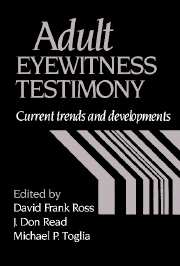Book contents
- Frontmatter
- Contents
- List of contributors
- Preface
- Part I Cognitive, physical and social processes and factors influencing eyewitness recall and identification
- Part II Lineup construction and collection of testimony
- 8 Conceptual, practical, and empirical issues associated with eyewitness identification test media
- 9 Biased lineups: Where do they come from?
- 10 Evaluating the fairness of lineups
- 11 Recommendations for properly conducted lineup identification tasks
- 12 Improving eyewitness testimony with the Cognitive Interview
- Part III Whom to believe? Distinguishing accurate from inaccurate eyewitnesses
- Name index
- Subject index
10 - Evaluating the fairness of lineups
Published online by Cambridge University Press: 04 August 2010
- Frontmatter
- Contents
- List of contributors
- Preface
- Part I Cognitive, physical and social processes and factors influencing eyewitness recall and identification
- Part II Lineup construction and collection of testimony
- 8 Conceptual, practical, and empirical issues associated with eyewitness identification test media
- 9 Biased lineups: Where do they come from?
- 10 Evaluating the fairness of lineups
- 11 Recommendations for properly conducted lineup identification tasks
- 12 Improving eyewitness testimony with the Cognitive Interview
- Part III Whom to believe? Distinguishing accurate from inaccurate eyewitnesses
- Name index
- Subject index
Summary
Although the accuracy of eyewitness identifications has long been a topic of debate (Levine & Tapp, 1982), only within the last decade have social scientists taken serious steps to empirically investigate this issue. Some years ago Wells, Leippe, and Ostrom (1979, p. 291) suggested that discussions of eyewitness accuracy were “subjective and confusing, with no empirical or scientific base.” One could argue that this statement still has the ring of truth to it, although it has been pointed out that incorrect eyewitness identifications appear to be the leading cause of wrongful criminal convictions in the American legal system (Huff, Rattner, & Sagarin, 1986; U.S. v. Wade, 1967; Wall, 1965). According to Huff et al. (1986), for example, erroneous eyewitness identifications could produce some three thousand wrongful felony convictions each year in the United States. Given this estimate, it is not surprising that a number of researchers have recently turned their attention to the study of eyewitness identification.
Concepts of lineup size and lineup bias
Early research in this area suggests that the likelihood of eyewitness misidentification is affected by the fairness of the lineup used (Malpass, 1981). In theory, a lineup is fair to the suspect when it contains a sufficient number of distractors (foils) who are similar in appearance to the prior description of the criminal (Doob & Kirshenbaum, 1973). In order to investigate this concept, two dimensions of lineup fairness have been proposed (Malpass, 1981; Malpass & Devine, 1983). First, the concept of lineup size suggests that a lineup should be large enough that the probability of a chance identification of an innocent suspect is relatively low.
- Type
- Chapter
- Information
- Adult Eyewitness TestimonyCurrent Trends and Developments, pp. 201 - 222Publisher: Cambridge University PressPrint publication year: 1994
- 9
- Cited by

